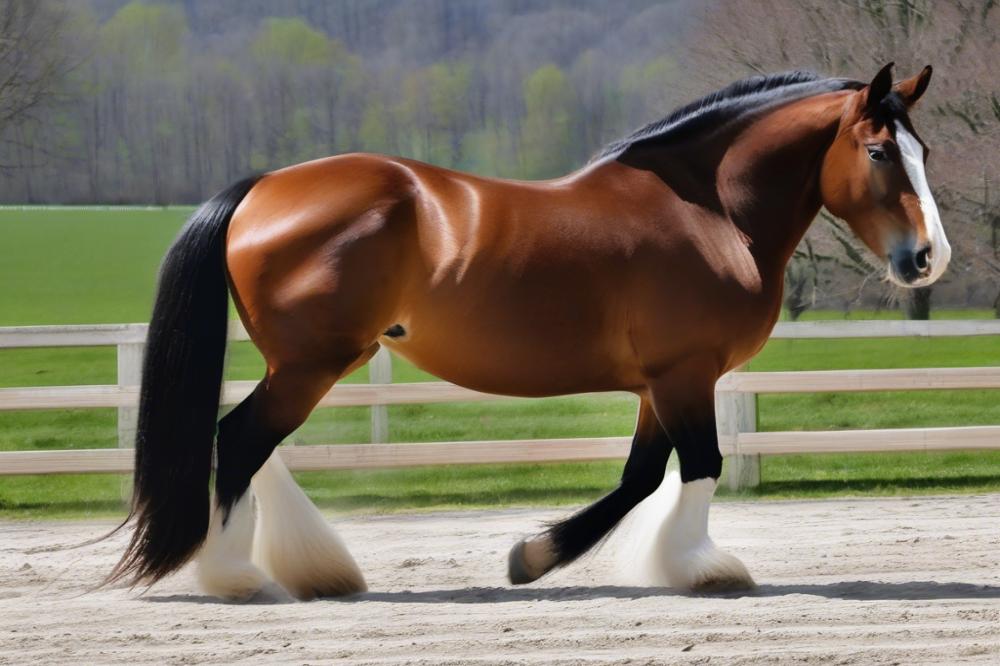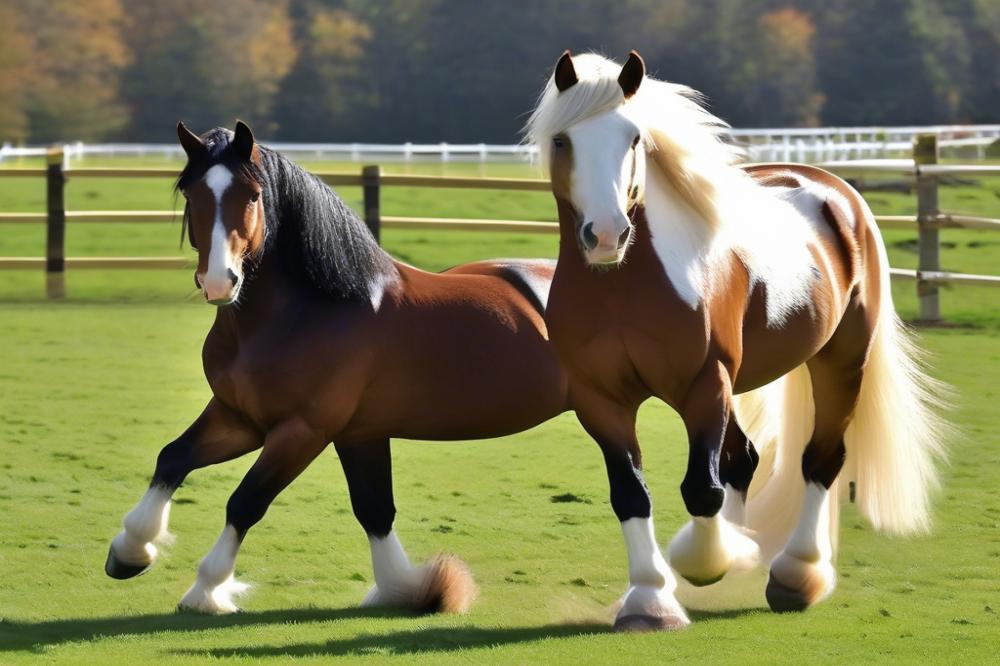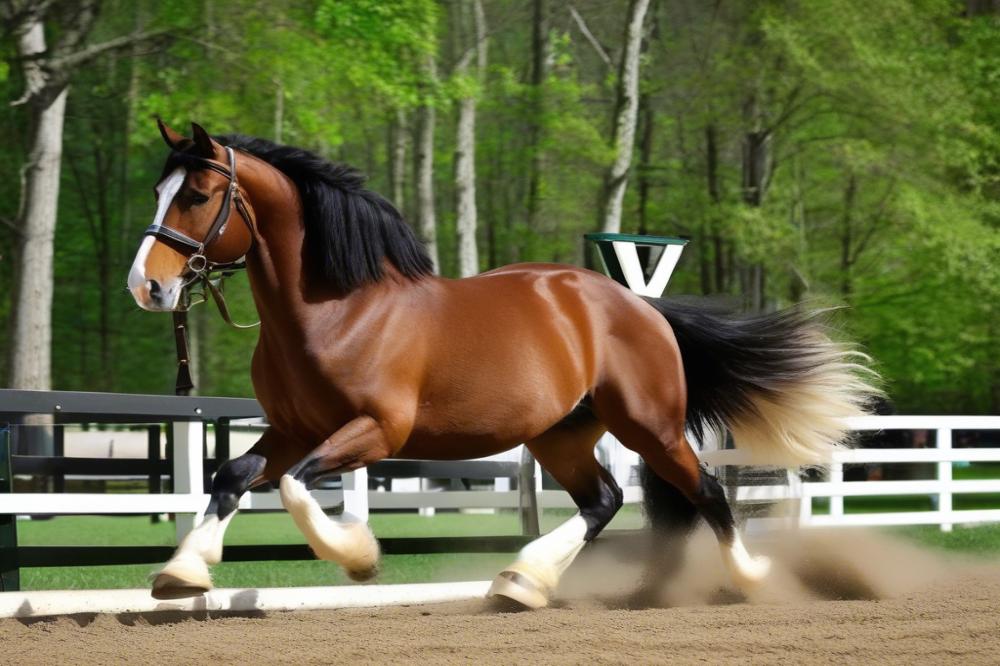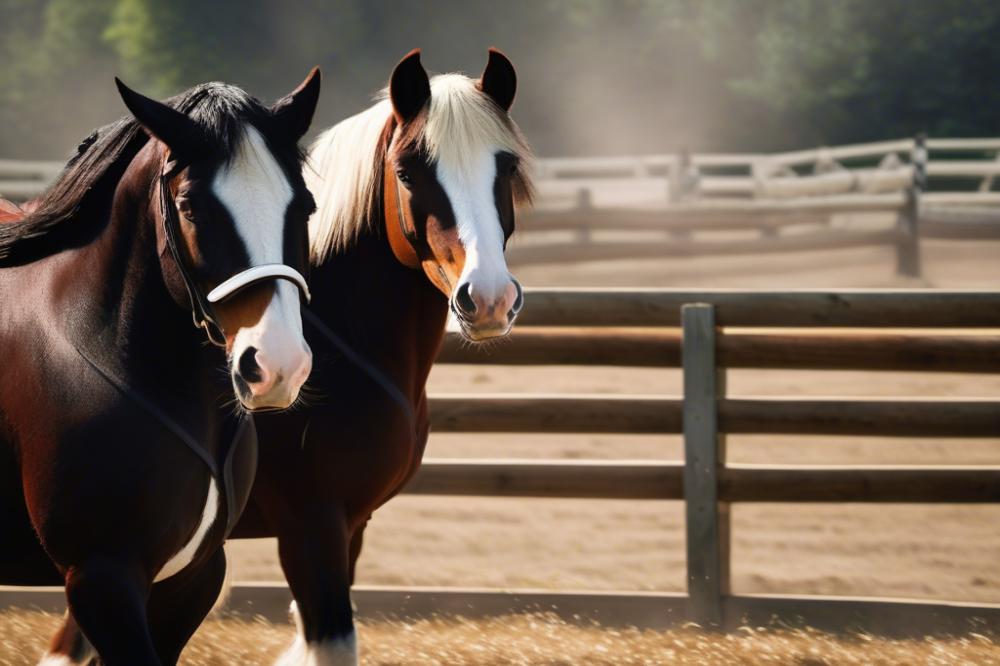Clydesdales and Belgians: Two Giants of the Horse World
When it comes to heavy horses, few can match the impressive presence of Clydesdales and Belgians. Both breeds boast remarkable size and strength, often making them the working champions of the equine world. Standing at around 16 to 18 hands tall, these gentle giants are not just about muscle; they have fascinating histories and unique traits that set them apart. Imagine a soft-eyed Clydesdale with its flowing mane strutting proudly, or a sturdy Belgian standing firm as a rock. There’s something enchanting about them.
One might wonder what exactly distinguishes these breeds of horse from each other. Clydesdales are known for their feathered legs and striking color patterns, often showcasing a beautiful bay coat with white markings. In contrast, Belgian horses often display a solid chestnut or blonde coat, characterized by their incredible body mass and strength. Each breed brings its own equine characteristics to the table, creating a rich tapestry of traits and abilities.
The purpose of this comparison is to dive deeper into what makes Clydesdales and Belgians truly special. You might find yourself pondering the best breed for your needs, your interests in farming, or your role as an equine enthusiast. Through an exploration of their traits, horse care requirements, and overall temperament, you’ll gain valuable insights. Expect to laugh a little and learn a lot, as we will also touch upon some of the quirks these horses possess.
No matter if you’re a novice or a seasoned expert, understanding the differences can lead to smarter decisions. After all, selecting a pair of shoes is challenging, but choosing a horse? That’s a whole new ballgame! Along the way, we’ll sprinkle in some comparisons with other popular breeds, including a nod to the wonderful indian horse breeds that enrich our understanding of equine diversity. Buckle up as we embark on this captivating journey of discovery!
Clydesdale Overview

Origin and History of Clydesdales
Clydesdales hail from Scotland. They emerged in the late 1700s, mainly in the Clydesdale River area. Farmers needed strong horses for heavy farm work. The breed was a perfect answer. Over time, they gained popularity for pulling beer wagons for breweries, especially Anheuser-Busch. Imagine a big, majestic horse clomping down the street while carrying a load of frothy beer! Their rich history makes them a favorite among many horse lovers today.
Physical Characteristics and Size
These horses are remarkably large. Usually, they stand anywhere from 16 to 18 hands high. A hand is four inches, so that’s quite a height for an animal! Clydesdales are known for their strong, muscular bodies. They usually have a thick neck and broad chest. The coat is often bay, though you can find them in a variety of colors. White markings on the face and legs are common. Their feathering—long hair on their lower legs—adds to their charm. When you see one, you can’t help but admire its beauty and strength.
Temperament and Personality Traits
Clydesdales are known for their gentle nature. Don’t let their size fool you; they have a heart of gold! Generally, they are friendly, making them a good choice for families. Training them can be quite straightforward due to their calm demeanor. Many people choose them for horse riding or driving because they are eager to please. When it comes to horse care, regular grooming is a must. Their feathered legs need extra attention to keep them free from mud and debris. Overall, these horses exhibit a blend of strength and sweetness, making them a joy to be around.
Belgian Overview

Origin and History of Belgians
Belgians have quite a storied past. These strong horse breeds originated in Belgium and were bred for heavy agricultural work. Farmers selected them for their size and power, making them valuable for plowing fields and pulling carts. The breed’s history dates back to the Middle Ages, where they played a crucial role in agriculture. During the World Wars, Belgians served in the military as draft horses, proving their worth beyond the farm. Over time, these horses have developed a grand reputation for strength and reliability.
Physical Characteristics and Size
When you see a Belgian, their size can be quite impressive. Typically, they stand about 16 to 17 hands high, but some can be even taller. These horses often weigh between 1,800 to 2,200 pounds, making them one of the largest horse breeds around. Their coats can come in various shades, often a striking chestnut or bay. A distinctive feature is their thick, powerful build. They have sturdy legs and wide hooves, designed for heavy work. Mane and tail are usually long and flowing, giving them an elegant look as they trot.
Temperament and Personality Traits
Belgians are known for their gentle nature. People often describe them as calm and friendly, making them easy to handle. They usually get along well with other animals too, which is a plus on busy farms. Training these horses can be a joy. They tend to be curious and eager to please. However, their size means you’ll need to approach them with confidence. Once you do, they often respond beautifully to commands. They require consistent horse care, including regular exercise and social interaction. Overall, Belgians are sweet giants with a heart as big as their bodies.
Clydesdale vs Belgian: Physical Comparison

Size and Weight Differences
When comparing these horse breeds, size is a big deal. Clydesdales often stand between 16 to 18 hands tall. That’s like looking up at a giant! On the other hand, Belgians are typically a bit stockier, measuring around 16 to 17 hands. Weight varies too. A Clydesdale usually tips the scales at about 1,600 to 2,000 pounds. Meanwhile, a Belgian can weigh anywhere from 1,800 to 2,200 pounds. If you watch them side by side, it’s like comparing apples and oranges, or maybe apples and watermelons!
Coat Color and Markings
Color certainly adds spice to these breeds. Clydesdales are known for their striking coat patterns. You’ll often spot them in bay colors adorned with white markings. Their faces sometimes look like they wore a dab of paint! In contrast, Belgian horses mainly flaunt a chestnut coat, often reflecting a golden hue in sunlight. If you squint, you might see some with flaxen manes and tails. Those flowing locks can really catch your eye! Both breeds have their own flair when it comes to looks, making them appealing for different reasons.
Conformation and Build
Let’s talk about build! Clydesdales display a unique refinement in their stature. Their legs are long, strong, and often feathered at the bottom, which gives them a majestic appearance. This feathering is like nature’s very own fringe! Conversely, Belgians have a broader frame. They boast powerful shoulders and thick necks, perfect for heavy work. Imagine lifting the heaviest grocery bags every week! Their muscular build is no accident. Each breed has developed its own distinctive conformation over time, emphasizing different equine characteristics. Whether you prefer the slender grace of a Clydesdale or the beefy strength of a Belgian, there’s something truly remarkable about both.
These differences underscore why horse care can vary between breeds. Clydesdales might need extra attention to their feathering, while Belgians may require more strength training. So, choosing one often comes down to personal taste and the specific tasks you want them to tackle.
Clydesdale vs Belgian: Purpose and Use
Work and Farming Roles of Clydesdales
Clydesdales are famous for their strength and size. Traditionally, these horse breeds pulled heavy loads on farms and in cities. Farmers relied on them for plowing fields, hauling goods, and even working in coal mines. Many people recognize them for their gentle nature and striking appearance. With their long legs and beautiful bay coats, Clydesdales are often seen as symbols of power and grace. They are dependable workers, making them popular in commercial settings for transport or logging.
Anyone who has witnessed a Clydesdale in action can appreciate their impressive capabilities. When you watch them move, it’s almost poetic. Despite their large stature, these horses can be surprisingly agile. When it comes to horse care, Clydesdales generally need plenty of space to roam and forage. Their character allows them to work in pairs or teams, promoting teamwork like a well-rehearsed dance.
Work and Farming Roles of Belgians
Belgians also shine in work and farming roles. This breed is another heavyweight champion in the equine world. Known for their muscular build and calm demeanor, they excel at farming tasks. You might find a Belgian plowing fields or pulling logs out of the woods. Their strength is remarkable, and they can handle tremendous amounts of weight. Farmers appreciate their robustness.
In addition, Belgians are friendly and tend to form close bonds with humans. This relationship makes them easier to train compared to some other horse breeds. Their patience is a great asset when dealing with the demands of farm life. Routine horse breed comparisons often highlight how these traits benefit the farm.
Recreational Uses and Competition
Beyond work, Clydesdales and Belgians bring joy to many people in recreational settings. Both breeds participate in competitions like pulling contests and draft horse shows. Picture a team of Clydesdales prancing in a parade or a group of Belgians showing their skills at a rural fair. Each event often attracts crowds, showcasing these magnificent horses in all their glory.
Moreover, pony rides and farm visits let children connect with these gentle giants. Families flock to farms where they can experience a day working alongside Belgians or Clydesdales. The joy radiating from these horses makes it a memorable outing. It’s not uncommon for people to develop a love for horse riding or farming during such experiences.
Despite their differences, both breeds captivate hearts. Each possesses traits that make them unique in their own right. Whether pulling a plow or participating in a friendly competition, these horses display their true spirit. The thrill of seeing them perform is unmatched, and it inspires many to learn more about horse care and the beauty of working with such incredible animals.
Clydesdale vs Belgian: Care and Maintenance
Feeding and Dietary Needs
Feeding these magnificent horse breeds requires attention to detail. Clydesdales are large and need a lot of food to match their massive size. They thrive on high-quality hay, grains, and fresh pasture. In contrast, Belgian horses also have substantial appetites, favoring a diet rich in fiber. They, too, benefit from hay and grains but also enjoy vegetables as treats. It’s like having two big, hungry kids at dinner. You wouldn’t serve them the same meal, right? Each horse needs proper nutrients for overall health. Horse care isn’t just about the food; it’s also vital to monitor their weight.
Grooming and Health Considerations
Grooming these gentle giants can be a workout! Clydesdales have thick coats and long feathers on their legs. Regular brushing helps remove dirt and loose hair. This task can become a bonding experience. Meanwhile, Belgian horses have a bit less feathering but can still shed plenty of fur. Skin health must not be ignored. Look for signs of irritation or infection during grooming. Keeping their hooves trimmed is essential, too. Neglected hooves can lead to real trouble. A farrier visit every few weeks keeps everything in tip-top shape.
Living Environment and Exercise Requirements
Space and fresh air are crucial for these equine companions. Clydesdales do best in large pastures where they can roam freely. Their playful nature means they enjoy good company—other horses or even humans! Belgians also need room to stretch their legs. Daily exercise helps ward off boredom and keeps them healthy. Consider setting up a safe paddock. Regular trots and walks will keep them fit and content. Horse breed comparison highlights that both require loving environments. Remember to check that gates and fences are secure. You never know when a curious horse might decide to explore!
Clydesdale vs Belgian: Popularity and Cultural Significance
Clydesdale’s Role in Pop Culture and Advertising
Have you ever seen those iconic Clydesdales pulling a beer wagon in a commercial? They seem to have a knack for stealing the spotlight. This horse breed carries a presence that commands attention. Their gentle demeanor and strength make them perfect for big events. People love them not just for their looks, but also their engaging personality. In popular culture, these majestic horses symbolize power and grace. They often represent big brands and joyful moments, especially during holidays.
Fans of Clydesdales often share videos and pictures online. Their striking appearance, with those fluffy feet and flowing manes, grabs attention on social media. Everywhere you look, Clydesdales seem to pop up! This breed has firmly rooted itself in the hearts of many. They invite a warm feeling, reminding folks of simpler times and community.
Belgian’s Representation in History and Agriculture
On the flip side, Belgians carry a different kind of legacy. Historically, these horses played a vital role on farms. They helped move heavy loads and worked alongside farmers for years. Imagine a time when machines didn’t exist; Belgians were the go-to workers! With their strength and endurance, they became beloved partners in agriculture. Farmers still admire their capabilities and loyalty.
Belgians are often associated with hard work and diligence. People recognize them not just as horses, but as vital contributors to rural life. Stories about their role in agriculture are still told today, highlighting their importance. Many also appreciate their calm nature when compared to other horse breeds. This breed’s incredible traits make them a favorite among those who work in heavy labor.
Comparison of Their Popularity in Modern Equestrian Communities
Among equestrian communities, both breeds have their fan clubs. However, their popularity can vary based on interests. Clydesdales attract those who enjoy shows or parades. Their flashy looks and amazing antics delight audiences. They are undeniably show-stoppers. In contrast, Belgian horse enthusiasts often focus on farm work and draft events. There’s a beauty in practicality with Belgians that speaks to many.
Different riders appreciate different equine characteristics. Clydesdales and Belgians offer something special whether it’s in competitions or ranch life. Often, people weigh the horse breed comparison and think about their needs. Do they want a charming show horse or a dependable work partner? Decisions can be tricky! In today’s world, both breeds continue to thrive, carving out their niche in hearts and homes.
People share stories about both breeds, creating vibrant discussions. Friendship and unity form around horses, no matter the breed. After all, who wouldn’t enjoy a good horse story?
Wrapping It Up
What a journey it has been exploring the fascinating world of Clydesdales and Belgians! Both these magnificent horses belong to the draft horse breed category, and they have their own charm and strengths. You might have noticed some key differences along the way, like the Clydesdale’s flashy feathering on their legs compared to the Belgian’s solid and stocky build. Yet, they share similarities too, such as their gentle temperament and incredible strength.
Choosing between these two breeds really boils down to your individual needs and preferences. Are you looking for a horse that stands out in parades and events? Perhaps the elegant Clydesdale is calling your name. On the other hand, if you need a strong workhorse that’s built like a tank, the Belgian might be the better choice. Either way, trust me, owning a horse from either group will be an experience like no other.
As you decide, imagine what you want from your horse. Are you hoping for a buddy to trot alongside you on leisurely trails, or do you need a steadfast companion for heavy work? These are important questions to ask yourself. Just like trying on clothes, you want to make sure the horse fits your lifestyle snugly. And who knows? You might find that you fall in love at first sight.
In the end, whether you lean toward the proud Clydesdale or the dependable Belgian, each has its own story to tell. The joy found in caring for and riding a horse is unmatched. So, take your time, weigh your options, and don’t forget to follow your heart. After all, horses have a wonderful way of reminding us what it feels like to be alive. Happy horse hunting!



